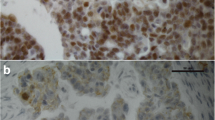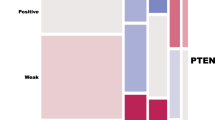Abstract
Objective
The role of molecular and biological factors in ovarian cancer is controversial. We investigated the levels of the estrogen (ER) and progesterone (PR) receptors, HER2/neu, p-53 and Ki 67 in patients with advanced ovarian cancer and correlated the results with the clinical course in order to define their predictive or prognostic significance.
Methods
Paraffin-embedded tumor tissues from 72 patients with ovarian cancer treated from 1999 to 2003 were analyzed. Overexpression of C-erb-B2 was defined as herceptest ++/+++ and positive fluorescence in situ hybridization (FISH) or herceptest +++/+++. Positivity for ER and PR was determined by ≥10% of the cellular membranes immunostained. Statistical analysis was performed to evaluate the prognostic impact of the molecular markers.
Results
49 of the 72 patients were ER + (68%) and 36 PR + (50%). In 45 patients (62.5%) expression of p53 was ≥10%. Overexpression of C-erb-2 was found in 4 tumor samples (5%). A Ki67 labelled nuclear area >30% was found to be associated with a higher rate of complete response (χ2; p=0.05). None of the biological markers were significantly associated with progression free survival (PFS). By multivariate analysis residual tumor after debulking surgery and ER status were associated with OS (p≤0.05).
Conclusions
Ki67 nuclear expression >30% is predictive of complete response in advanced ovarian cancer. HER2/neu overexpression is scarce in our study. Positive ER is an independent prognostic factor for OS. Further research with larger studies and hormonal treatment is guaranteed.
Similar content being viewed by others
References
Pettersson F (1994) Annual Report on the Result of Treatment in Gynaecological Cancer. FIGO, Stockholm, Sweden 22:83–102
Berek JS, Bertelsen K, du Bois A et al (1999) Advanced epithelial ovarian cancer: 1998 Consensus statements. Ann Oncol 10[Suppl 1]:S87–S92
Hawes D, Liu PY, Muggia FM et al (2002) Correlation of p53 immunostaining in primary and residual ovarian cancer at the time of positive second-look laparotomy and its prognostic role: a Southwest Oncology Group ancillary study. Gynecol Oncol 87:17–23
Nakayama K, Takebayashi Y, Nakayama S et al (2003) Prognostic value of overexpression of p53 in human ovarian carcinoma patients receiving cisplatin. Cancer Lett 192:227–235
Antilla M, Kosma VM, Ji H et al (1998) Clinical significance of alpha-catenin, collagen IV, and Ki-67 expression in epithelial ovarian cancer. J Clin Oncol 16:2591–2600
Santin AD, Bellone S, Gokden M et al (2002) Overexpression of Her-2/neu in uterine serous papillary cancer. Clin Cancer Res 8:1271–1279
Jones LA, Edwards CL, Freedman RS et al (1983) Estrogen and progesterone receptor titters in primary epithelial ovarian carcinomas. Int J Cancer 32:567–571
Therasse P, Arbuck SG, Eisenhauer EA et al (2000) New guidelines to evaluate the response to treatment in solid tumors. J Natl Cancer Inst 92:205–216
Couturier J, Vincent-Salomon A, Nicolas A et al (2000) Strong correlation between results of fluorescent in situ hybridization and immunohistochemistry for the assessment of ERBB2 (HER2/neu) gene status in breast carcinoma. Mod Pathol 13:1238–1243
Harding M, Cowan S, Hole D et al (1990) Estrogen and progesterone receptors in ovarian cancer. Cancer 65:486–491
Ozols RF (2000) Management of advanced ovarian cancer consensus summary. Semin Oncol 27[Suppl 7]:47–49
Schuijer M, Berns EMJJ (2003) TP53 and ovarian cancer. Hum Mutat 21:285–291
Havrilesky L, Darcy KM, Hamdam H et al (2003) Prognostic significance of p53 mutation and p53 overexpression in advanced epithelial ovarian cancer: a Gynecologic Oncology Group Study. J Clin Oncol 21:3814–3825
Okuda T, Otsuka J, Sekizawa A et al (2003) P53 mutations and overexpression affect prognosis of ovarian endometrioid cancer but not clear cell cancer. Gynecol Oncol 88:318–325
Van der Zee AGJ, Hollema H, Suurmeijer AJ et al (1995) Value of P-glycoprotein, glutathione S-transferase pi, c-erbB-2, and p53 as prognostic factors in ovarian carcinomas. J Clin Oncol 13:70–78
Marks JR, Davidoff AM, Kerns BJ et al (1991) Overexpression and mutation of p53 in epithelial ovarian cancer. Cancer Res 51:2979–2984
Gershenson DM, Deavers M, Diaz S et al (1999) Prognostic significance of p53 expression in advanced-stage ovarian serous border-line tumors. Clin Cancer Res 5:4053–4058
Thames HD, Petersen C, Petersen S et al (2002) Immunohistochemically detected p53 mutations in epithelial tumors and results of treatment with chemotherapy and radiotherapy. A treatment-specific overview of the clinical data. Strahlenther Onkol 178:411–421
Camilleri-Broët S, Hardy-Bessard AC, Le Tourneau A et al (2004) HER2 overexpression is an independent marker of poor prognosis of advanced primary ovarian carcinoma: a multicenter study of the GINECO group. Ann Oncol 15:104–112
Slamon DJ, Godephin W, Jones LA et al (1989) Studies of the HER2/neu proto-oncogene in human breast and ovarian cancer. Science 244:707–712
Slamon DJ, Clark GM, Wong SG et al (1987) Human breast cancer: correlation of relapse and survival with amplification of the HER2/neu oncogene. Science 235:177–182
Bookman MA, Darcy KM, Clarke-Pearson D et al (2003) Evaluation of monoclonal humanized anti-HER2 antibody, trastuzumab, in patients with recurrent or refractory ovarian or primary peritoneal carcinoma with expression of HER2: a phase II trial of the Gynecologic Oncology Group. J Clin Oncol 21:311–316
Medl M, Sevelda P, Czerwenkak et al (1995) DNA amplification of HER2/neu and INT-2 oncogenes in epithelial ovarian cancer. Gynecol Oncol 59:321–326
Rao BR, Slotman BJ (1996) Endocrine role in ovarian cancer. Endocr Relat Cancer 3:309–326
Wittliff JL (1984) Steroid-hormone receptors in breast cancer. Cancer 53[3 Suppl]:630–643
Pérez-Gracia JL, Carrasco EM (2002) Tamoxifen therapy for ovarian cancer in the adjuvant and advanced settings: systematic review of the literature and implications for future research. Gynecol Oncol 84:201–209
Van der Vange N, Greggi S, Burguer W et al (1995) Experience with hormonal therapy in advanced epithelial ovarian cancer. Acta Oncol 34:813–820
Schwartz PE, Chambers JT, Kohorn EI et al (1989) Tamoxifen in combination with cytotoxic chemotherapy in advanced epithelial ovarian cancer. A prospective randomized trial. Cancer 63:1074–1078
Emons G, Ortmann O, Teichert HM et al (1996) Luteinizing hormone-releasing hormone agonist triptorelin in combination with cytotoxic chemotherapy in patients with advanced ovarian cancer. Cancer 78:1452–1460
Markman M, Iseminger KA, Match KD et al (1996) Tamoxifen in platinum refractory ovarian cancer. A Gynecologic Oncology Group ancillary report. Gynecol Oncol 62:4–6
Bowman A, Gabra H, Langdon SP et al (2002) CA 125 response is associated with estrogen receptor expression in a phase II trial of letrozole in ovarian cancer: identification of an endocrine-sensitive subgroup. Clin Cancer Res 8:2233–2239
Papadimitriou CA, Markaki S, Siapkaras J et al (2004) Hormonal therapy with letrozole for relapsed epithelial ovarian cancer. Long-term results of a phase II study. Oncology 66:112–117
Author information
Authors and Affiliations
Corresponding author
Rights and permissions
About this article
Cite this article
García-Velasco, A., Mendiola, C., Sánchez-Muñoz, A. et al. Prognostic value of hormonal receptors, p53, ki67 and HER2/neu expression in epithelial ovarian carcinoma. Clin Transl Oncol 10, 367–371 (2008). https://doi.org/10.1007/s12094-008-0213-x
Received:
Accepted:
Published:
Issue Date:
DOI: https://doi.org/10.1007/s12094-008-0213-x




